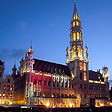ROYAL GALLERIES
SAINT-HUBERT
Brussels Shopping Arcade of the La Belle Bourgoises
 It
was the advent of the indoor shopping mall. In the early 1800s the
streets of Brussels
between the Marché aux Herbes and the Montagne
aux Herbes Potagères, (the grain and vegetable markets) a few
blocks from the Grand Place was a crowed and dark nest of street vendors
and alleyway shops where the growing middle-class of the “Bourgoises” with
rising wealth and good shoes would fear to tread, even for a bargain
of a sale. A young architect Jean-Pierre Cluysenaer, proposed building
an enclosed arcade, with a glass roof for light, to house luxury boutique
shops and some residences on upper floors. The Société des
Galeries Saint-Hubert was formed by Belgian banker Jean-André Demot
and others to build the project. His design was put forward in 1836,
but it took nine years of acquisition of properties and the liberal
application of eminent domain evictions to clear the way for construction
in 1845
by royal decree, and inaugurated in June of 1847 by King Leopold.
It
was the advent of the indoor shopping mall. In the early 1800s the
streets of Brussels
between the Marché aux Herbes and the Montagne
aux Herbes Potagères, (the grain and vegetable markets) a few
blocks from the Grand Place was a crowed and dark nest of street vendors
and alleyway shops where the growing middle-class of the “Bourgoises” with
rising wealth and good shoes would fear to tread, even for a bargain
of a sale. A young architect Jean-Pierre Cluysenaer, proposed building
an enclosed arcade, with a glass roof for light, to house luxury boutique
shops and some residences on upper floors. The Société des
Galeries Saint-Hubert was formed by Belgian banker Jean-André Demot
and others to build the project. His design was put forward in 1836,
but it took nine years of acquisition of properties and the liberal
application of eminent domain evictions to clear the way for construction
in 1845
by royal decree, and inaugurated in June of 1847 by King Leopold.
 The
Royal Galleries Saint-Hubert are in elegant Italianate style of pilaster
columns and a cast iron framework roof of arched glass panes.
The arcade
consist of two intersecting sections, each about the length of a
football field, the Galerie du Roi (King’s Gallery) and the Galerie
de la Reine (Queen’s Gallery) with a smaller side arcade, the Galerie
des Princes, you get the idea. The galleries originally housed up
to seventy luxury boutique stores, and a hundred private apartments,
though
the number of stores is now just over fifty. The outdoor cafés
protected from Brussels changeable weather by the glass roof and
the elegance of the shop attracted the fashionable society of the
day and
became a hit. The success of the Galeries Royal in Brussels (Koninklijke
Sint-Hubertusgalerijen in Dutch) prompted other cities of the 19th
Century to follow suit with similar projects, sweeping European capitals,
such
as the Galleria Vittoria Emanuele II in Milan (see Milan’s
Galleria Vittoria),
the Vladimirsky Passage in Saint Petersburg, the Ilica in Zagreb
(see Zagreb)
and the Passage Choiseul and Galery Vivienne in Paris.
The
Royal Galleries Saint-Hubert are in elegant Italianate style of pilaster
columns and a cast iron framework roof of arched glass panes.
The arcade
consist of two intersecting sections, each about the length of a
football field, the Galerie du Roi (King’s Gallery) and the Galerie
de la Reine (Queen’s Gallery) with a smaller side arcade, the Galerie
des Princes, you get the idea. The galleries originally housed up
to seventy luxury boutique stores, and a hundred private apartments,
though
the number of stores is now just over fifty. The outdoor cafés
protected from Brussels changeable weather by the glass roof and
the elegance of the shop attracted the fashionable society of the
day and
became a hit. The success of the Galeries Royal in Brussels (Koninklijke
Sint-Hubertusgalerijen in Dutch) prompted other cities of the 19th
Century to follow suit with similar projects, sweeping European capitals,
such
as the Galleria Vittoria Emanuele II in Milan (see Milan’s
Galleria Vittoria),
the Vladimirsky Passage in Saint Petersburg, the Ilica in Zagreb
(see Zagreb)
and the Passage Choiseul and Galery Vivienne in Paris.
 In
1857, Swiss chocolatier Jean Neuhaus moved his confection shop to the
galleries and in 1912, along with his son Frederic, introduced a
treat of chocolate filled with crushed nut paste and varieties of cream,
cherries and liquors he called Pralines, which came to be know as Belgian
chocolates (see Brussles Chocolate Museum). Today, the presences of the
chocolate shops in the arcade, alongside the fine Belgian lace, gloves
and hats, jewelry, leather, haute couture fashion, and book shops still
evoke a time gone by of parasols and carriages. Sure there’s modern
shopping stores and restaurants, but the galleries for a stroll through
the grand Belle Epoch or for an afternoon tea or coffee, is a Belgian
treat in itself. © Bargain
Travel Europe
In
1857, Swiss chocolatier Jean Neuhaus moved his confection shop to the
galleries and in 1912, along with his son Frederic, introduced a
treat of chocolate filled with crushed nut paste and varieties of cream,
cherries and liquors he called Pralines, which came to be know as Belgian
chocolates (see Brussles Chocolate Museum). Today, the presences of the
chocolate shops in the arcade, alongside the fine Belgian lace, gloves
and hats, jewelry, leather, haute couture fashion, and book shops still
evoke a time gone by of parasols and carriages. Sure there’s modern
shopping stores and restaurants, but the galleries for a stroll through
the grand Belle Epoch or for an afternoon tea or coffee, is a Belgian
treat in itself. © Bargain
Travel Europe
Find best hotel and travel deals in Brussels on TripAdvisor
Web Info
Galleries
St Hubert
These articles are copyrighted and the sole property of Bargain Travel Europe and WLPV, LLC. and may not be copied or reprinted without permission.
SEE ALSO:
ATOMIUM & MINI EUROPE - BRUSSELS BRUPARCK
AUTOWORLD BELGIUM CINQUANTENAIRE

